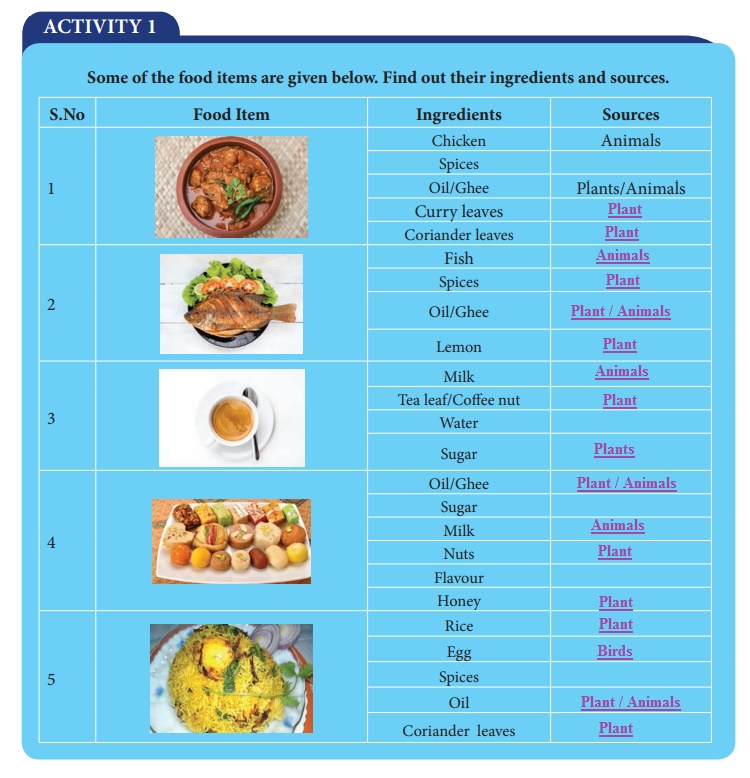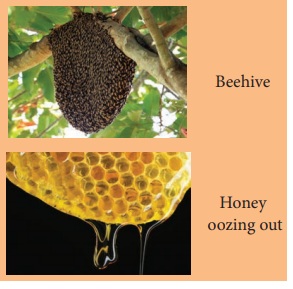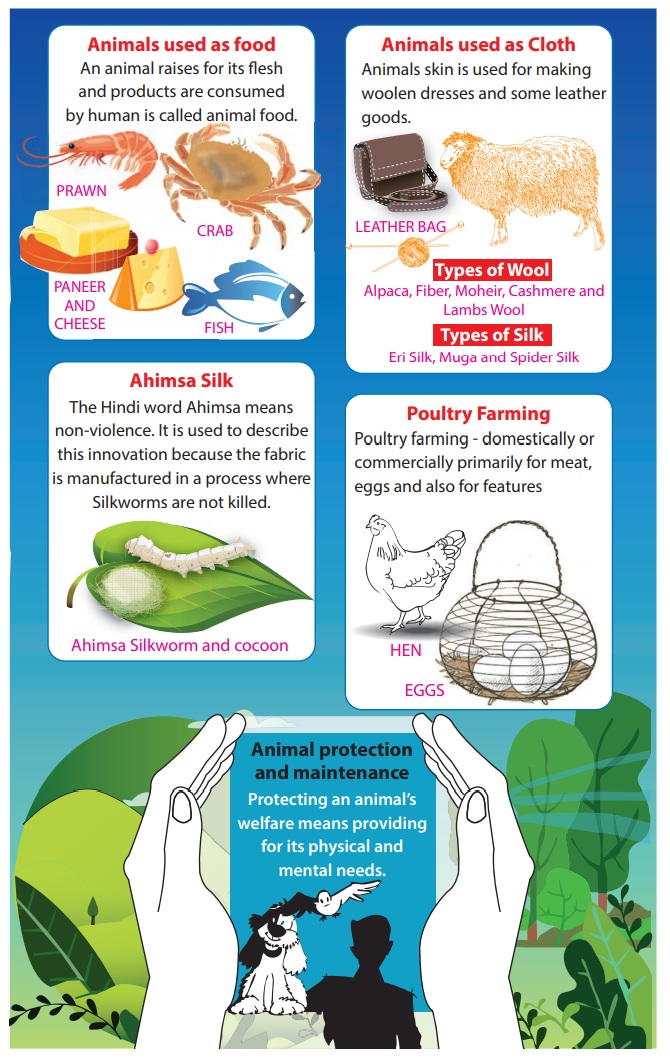Science : Term 3 Unit 5 : Animals in Daily Life
EVALUATION
I. Choose the correct answers
1. _________ is the daily essential product which is obtained from cattle.
a. Egg
b. Milk
c. Both of them
d. None of them
[Answer: (b) Milk]
2. Eggs are rich in _________.
a. Protein
b. Carbo hydrate
c. Fat
d. Acid
[Answer: (a) Protein]
3. Which parts of the goat and sheep is used for manufacturing clothes.
a. Leg
b. Hand
c. Hair
d. Head
[Answer: (c) Hair]
4. The cultivation and production of silk is known as . _________
a. Horticulture
b. Floriculture
c. Agriculture
d. Sericulture
[Answer: (d) Sericulture]
5. Sorter’s Disease is otherwise known as
a. Asthma
b. Anthrax
c. Typhoid
d. Cholera
[Answer: (b) Anthrax]
II. Fill in the blanks.
1. Proteins and calcium is rich in milk.
2. Honey is extracted from bee hives.
3. Anthrax is caused by Bacillus anthracis.
4. Silk is the strongest natural fibre.
5. Peace silk was produced in the year 1992.
III. True or False – If False give the correct answer
1. Animals are the greatest gift of nature. Answer: True.
2. Horse hair is used as bristles in small painting brushes. Answer: True.
3. Wool is the fibre derived from the silk worm. Answer: False.
Correct statement: Silk is the fibre derived from the silk worm.
4. Ahimsa silk is otherwise known as Mulberry silk. Answer: False.
Correct statement : Ahimsa silk is otherwise known as peace silk.
5. Pencillin is the best medicine for curing Anthrax. Answer: True.
IV. Match the following
1. Cocoons – Meat
2. Peace silk – Poultry
3. Broilers – Silk worm
4. Sweet Liquid – Andhra pradesh
5. Goat – Honey
Answer:
1. Cocoons – Silk worm
2. Peace silk – Andhra pradesh
3. Broilers – Poultry
4. Sweet Liquid – Honey
5. Goat – Meat
V. Analogy
1. Water : pipe : Electric current :: Wire
Answer: Wire
2. Copper : conductor : wood :: Non conductor
Answer: Non conductor
3. Length : metre scale : current :: Ampere
Answer: Ampere
4. Milli ampere: micro ampere: 10-3A :: I0-6 A.
Answer: I0-6 A.
VI. Very short answer
1. Write about any two dairy products.
Answer:
(i) Paneer,
(ii) Cheese
These two are dairy products. They are Nutritive food containing protein and calcium are made from milk.
2. What are the two types of fibres that are obtained from animals?
Answer:
(i) Wool – silk fibre is obtained from the cocoon of silkworm.
(ii) Wool is got from fleece of sheep or goat
3. What is shearing?
Answer: The fleece of the sheep is removed from its body. This is called shearing.
4. Write the symptoms of Anthrax
Answer:
(i) The symptoms are fever, cough and shortness of breathe, similar to a typical pneumonia.
(ii) Sometimes it may leads to nausea, vomiting and diarrhoea.
5. Define – Sericulture
Answer:
(i) Sericulture or silk farming is the cultivation of silk worm to produce silk.
(ii) It is the rearing of silk worms to obtain silk.
6. How should we treat animals?
Answer:
(i) We must love and protect animals.
(ii) We should safeguard them and treat them with care.
7. Who invented the Ahimsa silk?
Answer: Kusuma Rajaiah, a Government officer from Andhra Pradesh proposed Ahimsa way of silk production for the making silks without killing the silkworms.
VII. Short Answer Questions
1. What are the characteristics of wool? Give any three.
Answer:
(i) It is resistant to heat, water, wear and tear.
(ii) It absorbs moisture.
(iii) Wool insulates against cold. So wool is a good insulator.
(iv) It does not wrinkle easily.
2. Write about any three uses of silk.
(i) Silk has natural beauty and elegance.
(ii) It gives comfort in warm weather and warmth during colder months.
(iii) It is used in the manufacture of classical and high fashion clothes, modern dresses particularly silk sarees, the elegant of beautiful dresses.
(iv) It is also used in household for making wall hangings, curtains, rugs and carpets.
(v) It’is also being used in the manufacture of surgical threads for sutures.
3. What are the common diseases that are found in Poultry?
Answer:
Salmonellosis (diarrhoea) – Caused by bacteria
Ranikhat disease, (Fowl pox) – Caused by virus
Aspergilleses – Caused by fungus
VIII. Answer in Detail
1. Write about Ahimsa Silk.
Answer:
(i) It is also known as Peace silk.
(ii) In 1992, Kusuma Rajaiah, a Government officer from Andhra Pradesh state of India proposed ahimsa way of silk production for the making silks without killing the silkworm.
(iii) It involves a humane method specifically letting the worms to hatch and then using the vacant cocoons.
(iv) Traditional silk manufacturing methods involve boiling the cocoons of the silk worms and then sorting out the threads, which is used later in silk production.
(v) It has been supported by many people who are interested in the welfare of animals.
2. Write about the hazards of silk industry.
Answer:
(i) Generally, the workers in silk industry affected with arthritis is they stand for a long time reeling the silk into yarn.
(ii) They also develop back pain and visionary problem and skin injuries.
(iii) Some time they may suffer from respiratory problem like asthma and bronchitis due to poor ventilated area of their work.
3. What are the major steps involved in this wool factory.
Answer:
(i) The processing of wool involves five major steps.
(ii) They are as follows Shearing, Grading (or) Sorting, Washing (or) Scouting, Carding and Spinning.
(iii) Shearing:- The fleece of the sheep is removed from its body. This is called shearing.
(iv) Grading (or) Sorting:- The fleece from the same sheep may be different from different parts of the body. It is sorted out into separate piles of similar nature. This is known as Grading (or) Sorting.
(v) Washing (or) Scouting:- The sheared skin is washed thoroughly with soap (or) detergents to remove dirt, dust and grease.
(vi) Carding:- The dried wool is carefully removed. These fibres then passed through the rollers which are covered with fine sheet of thin wire teeth. This process arranges the wool into a flat sheet called a web.
(vii) Spinning:- The web is drawn into narrow strand and then passed through spinning machines. The spinning machines twist the strands into yarn. The yarn is wound to form balls of wool. This yarn is either weaved into fabric (or) retained for knitting.
4. Write the uses of the wool.
Answer: (i) Wool is a multifunctional fibre with a range of diameters that makes it suitable for clothing, household fabrics and technical textiles.
(ii) Two third of wool is used in the manufacture of garments including sweaters, dresses, coats and active sportswear.
(iii) Blended with other natural (or) synthetic fibres wool used as adds drape and crease resistance blankets, anti-static and noise absorbing carpels.
IX. HOTS
1. Silk fiber is used to manufacture parachute. Why?
Answer:
(i) Silk is the strongest natural fibre.
(ii) It is thin light in weight, strong.
(iii) It is easly to peak and unfold.
(iv) It is also fire resistant.
(v) It is dries quickly.
(vi) It is also resistant to abrasion and chemicals.
2. Honey is recommended for all. Why? What is its significance.
Answer:
(i) Honey has high levels of sugar.
(ii) It has antiseptic and antibacterial properties.
(iii) It can prevent cancer, heart diseases reduce ulcer and digestive problems.
(iv) It also soothes coughs and sore throats.
(v) Hence it is recommended for all.
X. Assertion and Reasoning
1. Assertion : Wool is the fibre derived from the fur of animals.
Reason : Animals like goat, Yak, Alpaca and rabbit yields wool.
a. Both Assertion and reasoning is correct
b. Assertion is correct but reason in wrong
c. Assertion is wrong but reason is correct
d. Assertion and Reason are incorrect
[Answer: (a) Both Assertion and reasoning is correct]
2. Assertion : Pencillin or ciprofloxacin
Reason : These medicines cures cow pox.
a. Assertion is correct Reason is wrong
b. Assertion is wrong reason is correct
c. Assertion is wrong reason is also wrong
d. Assertion is correct and reason is correct.
[Answer: (d) Assertion is correct and reason is correct.]
Student Activities

ACTIVITY 2
Can you distinguish a fresh egg from a rotten one?
* Take a bowl of water.
* Put the egg in the bowl.
* Observe now, the fresh egg will sink. But the rotten egg will float.
ACTIVITY 3
Aim : To find out the purity of honey
Materials required : Water and honey.
Procedure : Take a glass of water, add a drop of honey to it. Observe carefully.
Inference : If the drop of honey reaches the bottom without dissolving, then the honey is pure. If the drop of honey dissolves before reaching the bottom then the honey is impure.
Honey
Where from honey comes, or how it is produced? Have you seen a beehive where many bees are seen buzzing about? Bees collect nectar (sweet juices) from flowers, convert it into honey and store in their honey comb.
* Honey is a sweet liquid produced by honey bees from the nectar of flowers. It is extracted from beehives by us.
* Raw organic wild honey is extracted from selected hives by tribal honey hunters, who collect it from jungles.
* Honey has more medicinal values and highly nutritious food.

The worker bees collect the nectar from the flowers. They nourish the young ones and repair the bee hive and also protect
India is the world’s second largest silk producing country. Kancheepuram, Thirubhuvanam and Arani are famous places for silk production in Tamil Nadu.
Study of breeding of animals and their maintenance is called Animal Husbandary















